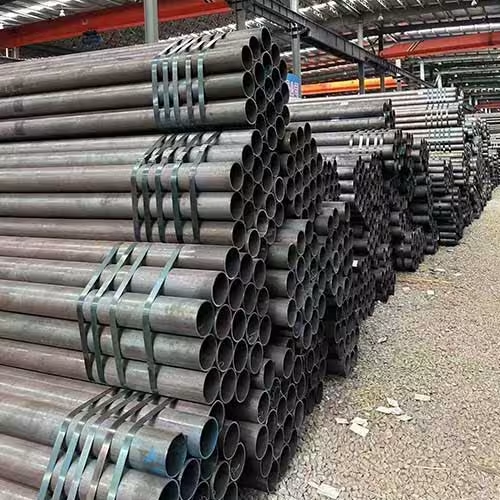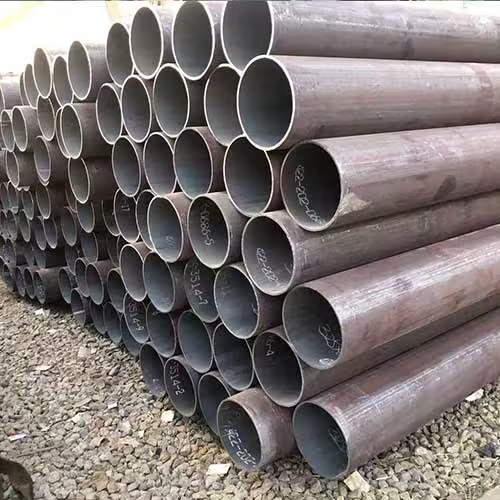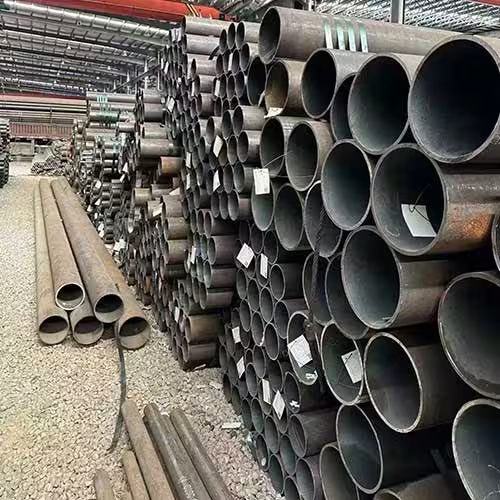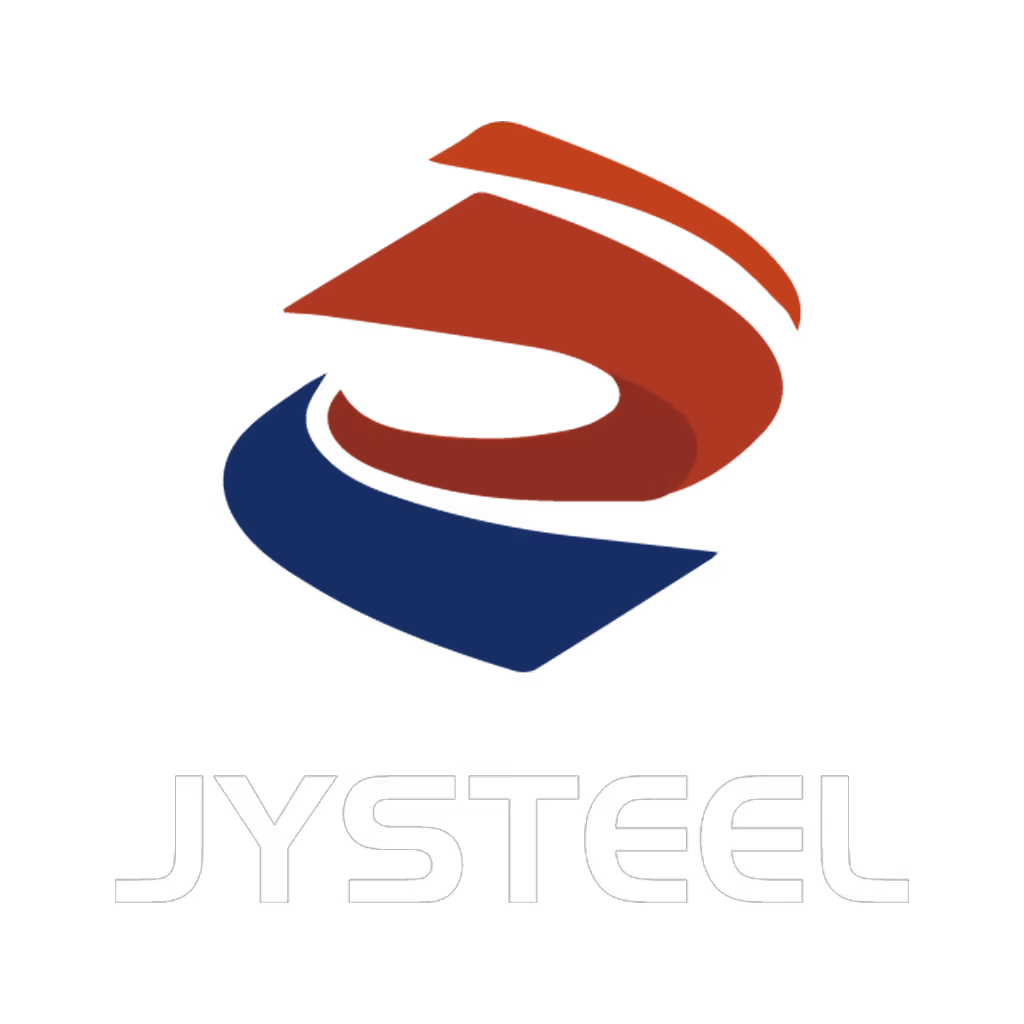مرحبًا بك في مدونتي!
قبل أن نتعمق في المحتوى، أود أن تنضموا إليّ على منصات التواصل الاجتماعي الخاصة بي حيث أشارك المزيد من الأفكار وأتفاعل مع المجتمع وأنشر التحديثات. إليك كيف يمكنك التواصل معي:
فيسبوك : فيسبوكhttps://www.facebook.com/profile.php?id=61565500692293
والآن، لنبدأ رحلتنا معًا. آمل أن تجدوا المحتوى هنا ثاقباً وجذاباً وقيّماً.
جدول المحتويات
مقدمة

The dimensions of carbon steel pipe are key specifications that determine its suitability for applications in industries such as oil and gas, construction, water treatment, and manufacturing. These dimensions, including nominal pipe size (NPS), outside diameter (OD), wall thickness, and length, are standardized to ensure compatibility, structural integrity, and performance under different pressures and environments.
Understanding the dimensions of carbon steel pipe is critical for engineers, contractors, and procurement experts to select the right pipe, and this article will provide you with knowledge about carbon steel pipe dimensions.
Understanding the Dimensions of Carbon Steel Pipe
What Are the Dimensions of Carbon Steel Pipe?
The dimensions of carbon steel pipe refer to the physical measurements that define a pipe’s size and capacity, including:
- حجم الأنبوب الاسمي (NPS): A standardized designation (e.g., NPS 2, NPS 10) indicating the approximate internal diameter, per ASME B36.10M.
- القطر الخارجي (OD): The external diameter (e.g., 60.3 mm for NPS 2), critical for fitting compatibility.
- سُمك الجدار: Measured in millimeters or schedule numbers (e.g., Schedule 40, 5.54 mm), affecting strength and pressure capacity.
- الطول: Typically 5.8–12 meters for standard pipes, with custom lengths available for specific applications.
These dimensions of carbon steel pipe are governed by international standards like ASTM A53, ASME B36.10M, and EN 10220, ensuring uniformity across industries such as oil refineries in France or construction projects in Poland.
Why Are the Dimensions of Carbon Steel Pipe Important?
The dimensions of carbon steel pipe directly influence their performance, safety, and compatibility in industrial systems. Key reasons for their importance include:
- السلامة الهيكلية: Appropriate wall thickness ensures pipes withstand internal pressures (e.g., 10–100 bar) and external loads, per EN 13480.
- توافق النظام: Standardized NPS and OD ensure seamless integration with fittings, valves, and flanges, critical for Germany’s petrochemical plants.
- Flow Efficiency: Internal diameter impacts fluid flow rates (e.g., 100–1000 m³/h), optimizing system performance in water treatment facilities in Spain.
- Regulatory Compliance: Adherence to EU standards like EN 10216 ensures safety and quality in high-pressure applications.
Understanding the dimensions of carbon steel pipe enables precise selection, reducing risks and enhancing efficiency in industrial projects across Europe.
Standardization and Measurement of the Dimensions of Carbon Steel Pipe
Standards Governing the Dimensions of Carbon Steel Pipe
The dimensions of carbon steel pipe are standardized to ensure consistency and interoperability across global markets. Key standards include:
- ASME B36.10M: Defines NPS, OD, and wall thickness for welded and seamless carbon steel pipes, widely used in the UK’s oil and gas sector.
- EN 10220: Specifies dimensions for seamless and welded steel pipes in Europe, ensuring compliance with EU pressure equipment directives (2014/68/EU).
- ASTM A53: Covers pipe dimensions for structural and pressure applications, common in construction projects in Italy.
- API 5L: Governs dimensions for line pipes in oil and gas pipelines, critical for Germany’s energy infrastructure.
These standards ensure the dimensions of carbon steel pipe meet rigorous quality and safety requirements, facilitating reliable performance in diverse applications.
Nominal Pipe Size (NPS) and the Dimensions of Carbon Steel Pipe
Nominal Pipe Size (NPS) is a standardized system for designating pipe sizes, typically ranging from NPS 1/8 (10.3 mm OD) to NPS 48 (1219.2 mm OD). Key aspects include:
- NPS vs. OD: For NPS ≤ 12, the OD is slightly larger than the nominal size (e.g., NPS 2 = 60.3 mm OD); for NPS ≥ 14, NPS equals OD, per ASME B36.10M.
- Internal Diameter: Varies with wall thickness, affecting flow capacity (e.g., 49.22 mm for NPS 2, Schedule 40).
- التطبيق: Smaller NPS (1/8–4) suits plumbing or low-pressure systems, while larger NPS (12–48) is used in pipelines, common in Spain’s water infrastructure.
The NPS system simplifies specifying the dimensions of carbon steel pipe, ensuring compatibility with fittings and systems across European industries.
Wall Thickness and Schedule in the Dimensions of Carbon Steel Pipe
Wall thickness, expressed in millimeters or schedule numbers (e.g., Schedule 10, 40, 80), determines a pipe’s strength and pressure rating. Key points include:
- Schedule Numbers: Indicate standardized thickness (e.g., Schedule 40 = 3.91 mm for NPS 2), per ASME B36.10M.
- نطاق السُمك: Varies from 1.65 mm (Schedule 5) to 12.7 mm (Schedule 160) for common NPS, supporting high-pressure applications in France’s refineries.
- Impact on Strength: Thicker walls increase burst pressure (e.g., 20–50 MPa for Schedule 80), critical for structural pipes in Poland’s construction sector.
Selecting the appropriate wall thickness ensures the dimensions of carbon steel pipe align with project requirements, balancing strength and weight.
Pipe Length and the Dimensions of Carbon Steel Pipe
The length of carbon steel pipes is a key dimension, typically standardized for manufacturing and transport efficiency. Considerations include:
- Standard Lengths: Single random (5.8–7 m), double random (11–12 m), or cut lengths (custom), per ASTM A53.
- Application-Specific Lengths: Shorter lengths (1–3 m) for plumbing; longer lengths (12 m) for pipelines, common in the UK’s gas distribution networks.
- التفاوتات المسموح بها: Length tolerances (±10 mm) ensure compatibility with fittings, per EN 10220.
Proper length selection optimizes the dimensions of carbon steel pipe, reducing waste and installation costs in European projects.
Comparison Table of the Dimensions of Carbon Steel Pipe
To assist in selecting the appropriate dimensions of carbon steel pipe, the following table compares common NPS sizes, their OD, wall thickness (for Schedules 40 and 80), and typical applications. This reference aids engineers and procurement specialists without including pricing information, as requested.
| NPS | Outside Diameter (mm) | Schedule 40 Wall Thickness (mm) | Schedule 80 Wall Thickness (mm) | التطبيقات النموذجية | المزايا | Limitations |
|---|---|---|---|---|---|---|
| 1/2 | 21.3 | 2.77 | 3.73 | Plumbing, low-pressure gas lines | Lightweight, easy to install | Limited pressure capacity |
| 2 | 60.3 | 3.91 | 5.54 | Water supply, structural supports | Versatile, moderate strength | Larger footprint |
| 6 | 168.3 | 7.11 | 10.97 | Oil pipelines, HVAC systems | High flow capacity | Heavy, requires robust fittings |
| 12 | 323.8 | 10.31 | 17.48 | Gas transmission, bridge construction | High strength, large diameter | Complex installation |
| 24 | 609.6 | 17.48 | 30.96 | Major pipelines, industrial frameworks | Massive capacity, durable | High weight, limited flexibility |
This table illustrates how the dimensions of carbon steel pipe vary by size and schedule, supporting applications from plumbing in Italy to pipelines in Germany, per standards like EN 10220 and ASME B36.10M.
Applications of the Dimensions of Carbon Steel Pipe

Dimensions of Carbon Steel Pipe in Oil and Gas Pipelines
The oil and gas industry relies on the dimensions of carbon steel pipe for safe and efficient fluid transport. Key applications include:
- Line Pipes: Large NPS (12–48) with thick walls (Schedule 80) for high-pressure gas transmission, common in Germany’s energy sector, per API 5L.
- Process Piping: Smaller NPS (1/2–4) for refinery systems, ensuring compatibility with valves, per EN 13480.
- Offshore Pipelines: Heavy-wall pipes (e.g., 20 mm thickness) for corrosion resistance in marine environments, used in Norway’s North Sea operations.
The dimensions of carbon steel pipe ensure durability and flow efficiency, critical for Europe’s energy infrastructure.
Dimensions of Carbon Steel Pipe in Construction and Structural Applications
In construction, the dimensions of carbon steel pipe support structural integrity and versatility. Applications include:
- Piling: Large NPS (12–24) with thick walls for foundation support in skyscrapers, common in the UK’s urban projects, per EN 10219.
- Scaffolding: Smaller NPS (1–2) for temporary structures, lightweight yet strong, used in Spain’s construction sites.
- Frameworks: Medium NPS (4–8) for industrial buildings, ensuring load-bearing capacity, per EN 10025.
The dimensions of carbon steel pipe enable robust, cost-effective solutions for Europe’s construction industry.
Dimensions of Carbon Steel Pipe in Water and Wastewater Systems
Water and wastewater systems depend on the dimensions of carbon steel pipe for reliable fluid transport. Applications include:
- Municipal Water Supply: NPS 2–12 with Schedule 40 for potable water distribution, common in France’s urban networks, per EN 10255.
- Sewage Lines: Large NPS (12–24) with corrosion-resistant coatings for wastewater, used in Poland’s treatment plants.
- Irrigation: Medium NPS (4–8) for agricultural water systems, ensuring high flow rates, per ISO 1127.
The dimensions of carbon steel pipe ensure efficient and durable water management, supporting Europe’s infrastructure needs.
Dimensions of Carbon Steel Pipe in Manufacturing and Industrial Systems
Manufacturing and industrial systems leverage the dimensions of carbon steel pipe for process efficiency. Applications include:
- أنظمة التدفئة والتهوية وتكييف الهواء: NPS 2–6 for air and coolant lines, balancing flow and pressure, common in Germany’s industrial facilities, per EN 10216.
- المعالجة الكيميائية: Small NPS (1/2–2) with thin walls for low-pressure fluids, used in Italy’s chemical plants.
- Steam Lines: Thick-wall NPS 4–8 for high-temperature steam, ensuring safety, per EN 13480.
The dimensions of carbon steel pipe support reliable performance in Europe’s diverse manufacturing sectors.
Practical Considerations for Selecting the Dimensions of Carbon Steel Pipe
Pressure and Temperature Requirements for the Dimensions of Carbon Steel Pipe
Selecting the dimensions of carbon steel pipe requires assessing pressure and temperature conditions. Considerations include:
- تصنيفات الضغط: Thicker walls (e.g., Schedule 80) support higher pressures (20–50 MPa), critical for oil pipelines in Norway, per ASME B31.3.
- Temperature Limits: Carbon steel pipes handle -29°C to 427°C, with thicker walls for high temperatures, used in France’s refineries.
- عوامل السلامة: Select dimensions with a safety margin (e.g., 1.5x operating pressure), per EN 13480.
Matching dimensions to pressure and temperature ensures the reliability of carbon steel pipes in demanding applications.
Corrosion and Environmental Factors in the Dimensions of Carbon Steel Pipe
Environmental conditions influence the dimensions of carbon steel pipe, particularly wall thickness and coatings. Key factors include:
- مقاومة التآكل: Thicker walls or galvanized coatings extend lifespan in marine environments, common in Spain’s coastal projects, per ISO 12944.
- Soil Conditions: Buried pipes require heavy walls (e.g., Schedule 80) to resist soil corrosion, used in Poland’s pipelines.
- Chemical Exposure: Thin-wall pipes with epoxy linings suit chemical plants, per EN 10208.
Selecting appropriate dimensions mitigates environmental risks, ensuring durability in European applications.
Installation and Handling of the Dimensions of Carbon Steel Pipe
The dimensions of carbon steel pipe impact installation and handling logistics. Considerations include:
- الوزن: Larger NPS and thicker walls increase weight (e.g., 50–500 kg/m for NPS 12), requiring cranes for installation, common in the UK’s construction sites.
- Joining Methods: Welding for large NPS, threading for small NPS, per EN 10253, ensuring secure connections in Germany’s pipelines.
- Transport: Standard lengths (5.8–12 m) fit shipping containers, reducing costs, per ISO 4200.
Proper handling and installation optimize the dimensions of carbon steel pipe, minimizing project delays and costs.
Environmental and Economic Benefits of the Dimensions of Carbon Steel Pipe

Environmental Sustainability and the Dimensions of Carbon Steel Pipe
The dimensions of carbon steel pipe contribute to sustainability by enhancing efficiency and durability. Benefits include:
- قابلية إعادة التدوير: Carbon steel is 100% recyclable, reducing waste, aligning with EU Directive 2008/98/EC on circular economy.
- طول العمر: Thicker walls extend service life (20–50 years), minimizing replacements in water systems in France.
- كفاءة الطاقة: Optimized dimensions reduce friction losses, lowering pumping energy in pipelines, per EN 16796.
These eco-friendly features make the dimensions of carbon steel pipe a sustainable choice for Europe’s infrastructure projects.
Economic Advantages of the Dimensions of Carbon Steel Pipe
Selecting the right dimensions of carbon steel pipe offers significant economic benefits. Advantages include:
- كفاءة التكلفة: Standardized dimensions reduce fabrication costs, ideal for large-scale projects in Spain.
- صيانة مخفضة: Durable pipes with thick walls lower repair frequency, critical in Germany’s industrial sector.
- Scalability: Wide range of NPS and schedules supports project scalability, from small plumbing to major pipelines in the UK.
These advantages make the dimensions of carbon steel pipe a cost-effective solution for competitive industrial markets.
الخاتمة
The size of carbon steel pipe is critical to its performance, safety, and compatibility in industries such as oil and gas, construction, and water treatment. By understanding standardization (e.g., ASME B36.10M, EN 10220), application, and selection criteria, professionals can select pipe that meets project requirements while optimizing efficiency and durability.
Need Reliable Carbon Steel Pipes?
We offer a wide range of seamless carbon steel pipes with various dimensions and specifications to match your project needs. Durable, high-quality, and competitively priced—just what your business demands.
الأسئلة الشائعة
What are the dimensions of carbon steel pipe?
The dimensions of carbon steel pipe include nominal pipe size (NPS), outside diameter (OD), wall thickness (e.g., Schedule 40), and length (5.8–12 m), per ASME B36.10M and EN 10220.
Why are the dimensions of carbon steel pipe important?
They ensure structural integrity, system compatibility, and flow efficiency, critical for applications like pipelines and construction, aligning with EU standards like EN 13480.
What standards govern the dimensions of carbon steel pipe?
ASME B36.10M, EN 10220, ASTM A53, and API 5L define NPS, OD, and wall thickness, ensuring consistency in industries like oil and gas in Germany.
How does wall thickness affect the dimensions of carbon steel pipe?
Thicker walls (e.g., Schedule 80) increase strength and pressure capacity (20–50 MPa), suitable for high-pressure systems in France, per EN 10216.
What industries use the dimensions of carbon steel pipe?
Oil and gas, construction, water treatment, and manufacturing rely on them for pipelines, structural supports, and process piping, per EN 10255 and API 5L.

